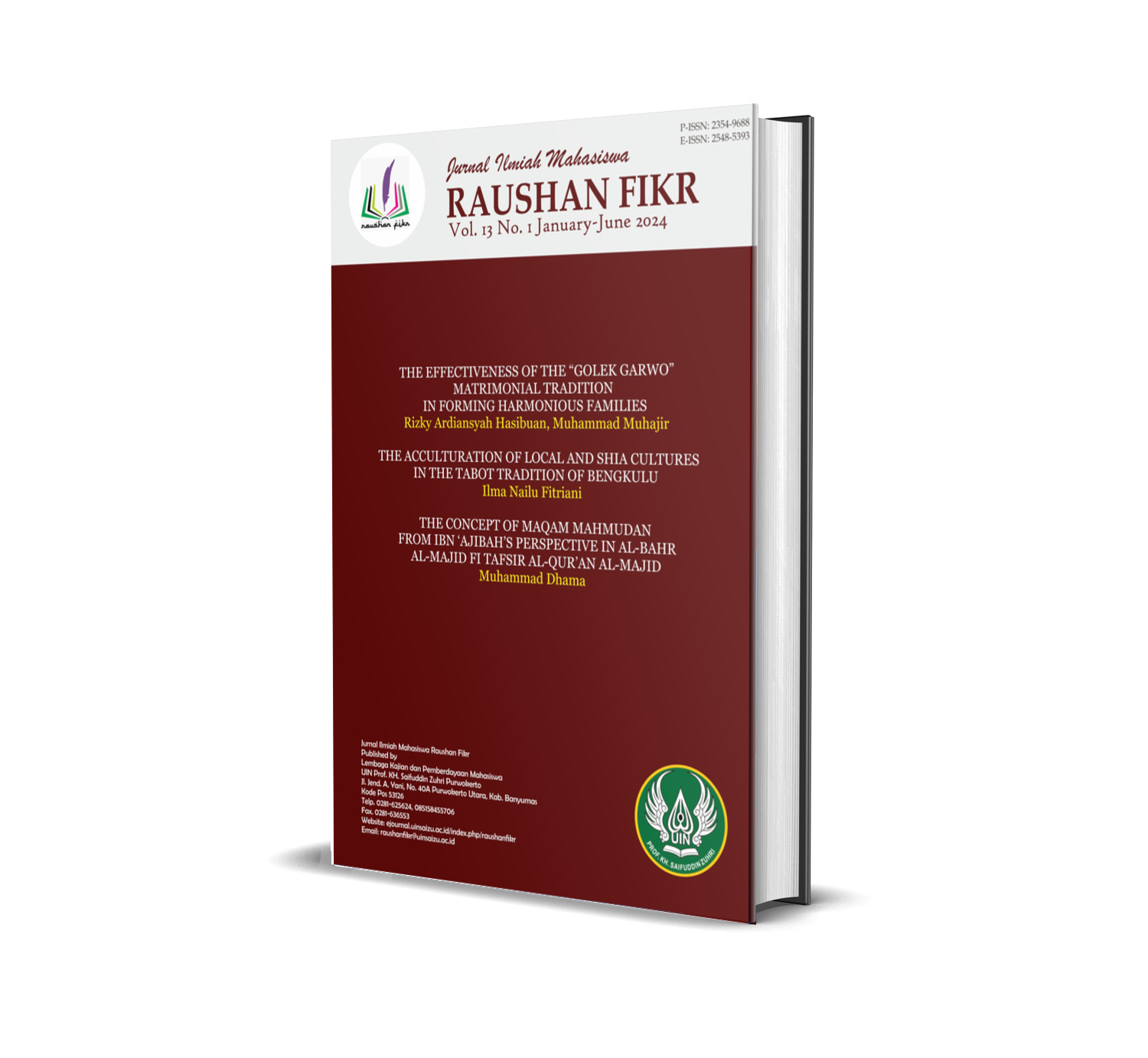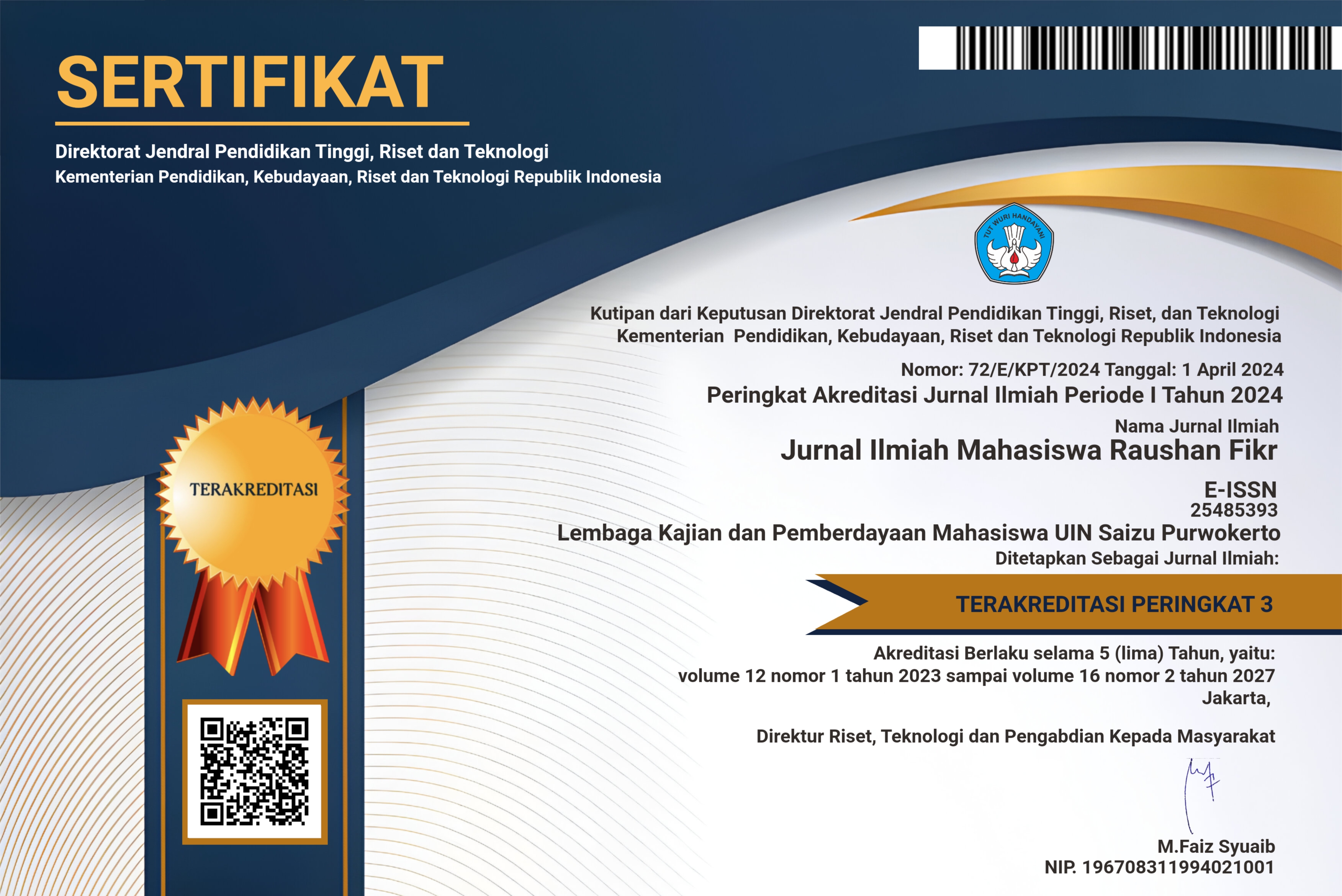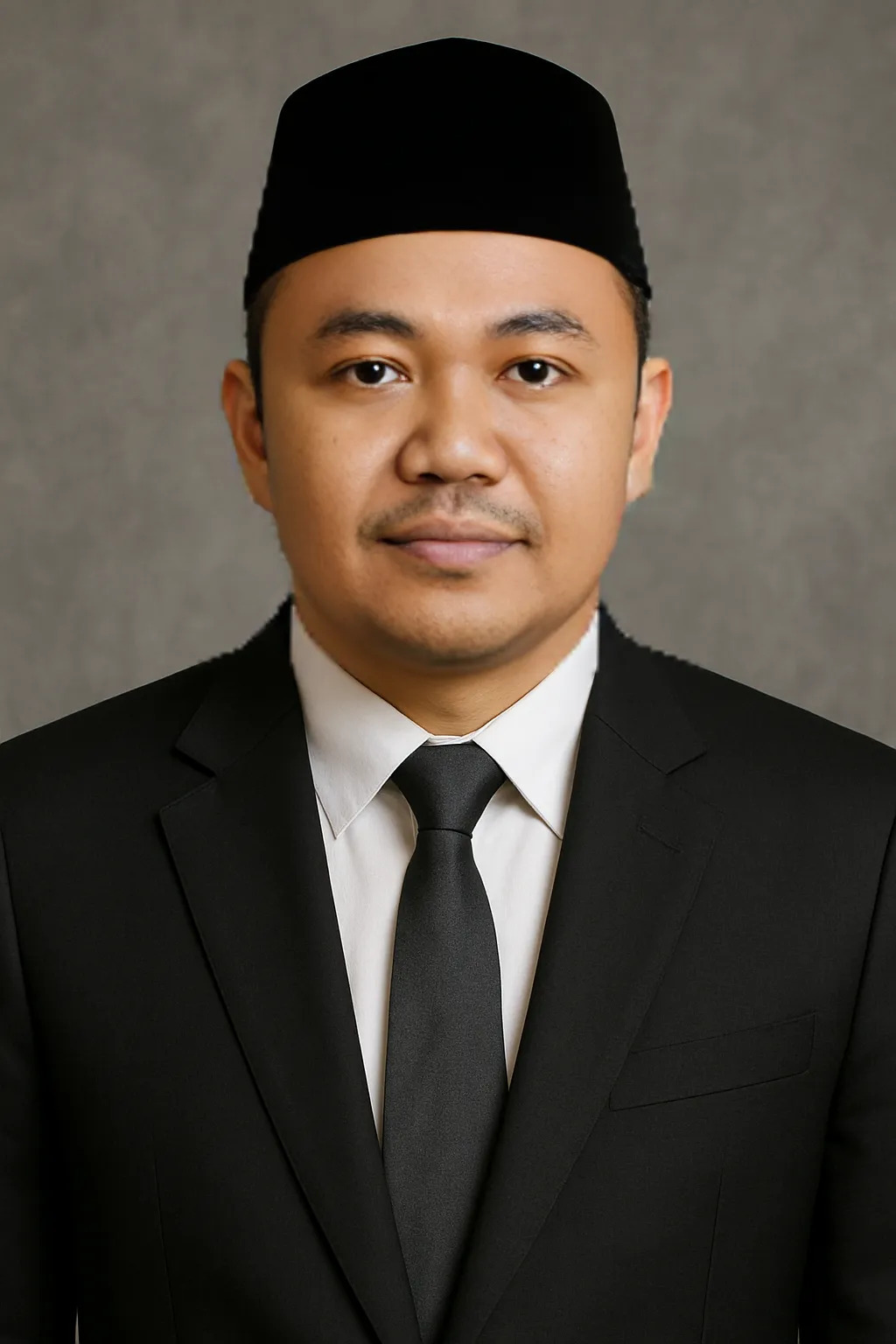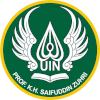The Acculturation of Local and Shia Cultures in the Tabot Tradition of Bengkulu
DOI:
https://doi.org/10.24090/jimrf.v13i1.11250Keywords:
Acculturation, Bengkulu, Shia, TabotAbstract
This study applies J. Powell’s theory of acculturation to analyze the cultural synthesis in the Tabot ceremony, examining the mutual influences between Shia traditions and Bengkulu’s indigenous practices. Utilizing a descriptive-qualitative methodology, the research involves comprehensive library research for historical and cultural contexts, complemented by fieldwork with the Kerukunan Keluarga Tabot (KTT), the tradition’s custodians. Data analysis follows a structured three-stage process: reduction, display, and conclusion drawing/verification. This approach ensures a thorough and accurate interpretation of findings. The Tabot ceremony commemorates the martyrdom of Prophet Muhammad’s grandson, Hussein bin Ali bin Abi Talib, in the battle against Ubaidillah bin Zaid’s forces in Karbala, Iraq, on the 10th of Muharram, 61 Hijri (681 AD). Initiated by Sheikh Burhanuddin, also known as Imam Senggolo, in 1685, the first Tabot celebration marked his union with a Bengkulu native, founding the Tabot lineage. This annual event spans from the 1st to the 10th of Muharram. Although originally a Shia Islamic rite, the Tabot ceremony transformed under the influence of Sunni Islam in Bengkulu, leading the descendants of Shia propagators to fervently adopt Sunni Islam. Despite this shift, they continue to observe the Tabot Ritual as a “universal Islamic religious rite” highlighting the doctrinal harmony between Shia and Sunni Islam. Thus, the Tabot Ritual is upheld as crucial for preserving and perpetuating ancestral heritageDownloads
References
Ahmad, Ukasyah Habibu. Sejarah Agung Hasan dan Husain. LAKSANA, 2022.
Am, Hurin’in, Liza Wahyuninto, and Erlina Zanita. “Kontestasi Dan Reintegrasi Nilai-Nilai Islam Pada Tradisi Tabot: Studi Hubungan Perayaan Tabot Dengan Kesadaran Mitigasi Bencana Di Bengkulu. “ Jurnal Ilmu Agama: Mengkaji Doktrin, Pemikiran, Dan Fenomena Agama 23, no. 1 (June 30, 2022): 76–94. https://doi.org/10.19109/jia.v23i1.13023.
Astuti, Linda. “PEMAKNAAN PESAN PADA UPACARA RITUAL TABOT (STUDI PADA SIMBOL-SIMBOL KEBUDAYAAN TABOT DI PROVINSI BENGKULU) “ 3 (2016).
Butsainah, Haniifah Irbah. “Tinjauan Hukum Islam Terhadap Tradisi Dan Budaya Tabot Di Kota Bengkulu, “ May 30, 2022. https://dspace.uii.ac.id/handle/123456789/39033.
Dahri, Harapandi. Tabot jejak Cinta Keluarga Nabi di Bengkulu. 1st ed. Jakarta: Gria Aksara Hikmah, 2009.
Fikriyah, Siti Zakiyatul, Indra Dwi Jayanti, and Siti Mu’awanah. “AKULTURASI BUDAYA JAWA DAN AJARAN ISLAM DALAM TRADISI POPOKAN “ 5, no. 2 (2020).
Fitrianah, Rossi Delta. “Nilai-Nilai Pendidikan Karakter Dalam Tradisi Tabot Pada Mata Pelajaran Sejarah Kebudayaan Islam Di Islamic Senior High School. “ Indonesian Journal of Character Education Research 1, no. 2 (November 29, 2023): 80–90.
Haryanto, Sri. “Pendekatan Historis dalam Studi Islam. “ Manarul QUr’an 17 (2017): 127.
Koentjaraningrat. Sejarah Teori Antropologi II. Jakarta: UI Press, 1990.
M, Sirajuddin. “‘Urf Dan Budaya Tabot Bengkulu. “ Millah: Journal of Religious Studies, 2012, 579–606. https://doi.org/10.20885/millah.volxi.iss2.art12.
Manulu, Ruhut. “Studi Eksperimen Musik Dol Band: Salah Satu Pengolahan Musik Dol Dalam Upacara Tabot Di Kotamadya Bengkulu Propinsi Bengkulu. “ Bengkulu: Departemen Pendidikan Dan Kebudayaan, 1994.
Maryani, Lesi. “JEJAK SYIAH DALAM KESENIAN TABOT BENGKULU; SUATU TELAAH SEJARAH “ 4, no. 1 (2018).
Mersyah, Rohidin, and Herawansyah Ikram. Perayaan Tabot di Kota Bengkulu dalam Perspektif Struktural Fungsional. Jakarta: Prenada, 2020.
Murtadlo, Agus Atiq. Akulturasi Islam dan Budaya Lokal dalam Tradisi Upacara Sedekah Laut di Pantai Teluk Penyu Kabupaten Cilacap, n.d.
Parmadie, Bambang, A. A. Ngurah Anom Kumbara, A. A. Bagus Wirawan, and I. Gede Arya Sugiartha. “Pengaruh Globalisasi Dan Hegemoni Pada Transformasi Musik Dol Di Kota Bengkulu. “ Mudra Jurnal Seni Budaya 33, no. 1 (February 6, 2018): 67–75. https://doi.org/10.31091/mudra.v33i1.240
Putra Padewa, Randa. “Dol Dan Tassa Dalam Upacara Ritual Tabut Pada Masa Pandemi Covid-19 Di Kota Bengkulu. “ Skripsi, Institut Seni Indonesia Yogyakarta, 2022. http://lib.isi.ac.id.
Qaidar, Annurul, and Nur Annisah M Si. “Jurnal Ilmiah Mahasiswa FISIP Unsyiah Volume 3, Nomor 3 Agusutus 2018 www.jim.unsyiah.ac.id/FISIP “ 3 (2018).
Rahman, Andi Tri, and Amnah Qurniati. “PERAN TOKOH MASYRAKAT DALAM MELESTARIKAN BUDAYA TABOT DI KOTA BENGKULU. “ Jurnal Pancasila Dan Kewarganegaraan (JUPANK) 2, no. 2 (November 27, 2022): 129–40.
Renta, Person Pesona. “TABOT Upacara Tradisi Masyarakat Pesisir Bengkulu. “ Sabda: Jurnal Kajian Kebudayaan 6, no. 1 (April 1, 2011): 47–55. https://doi.org/10.14710/sabda.6.1.47-55.
Ridlo, Miftakhur, and Moch Yunus. “Dialektika Sunni Dan Syi’ah Dalam Pemikiran Politik Islam. “ Asy-Syari’ah : Jurnal Hukum Islam 8, no. 2 (July 14, 2022): 50–64. https://doi.org/10.55210/assyariah.v8i2.846.
Rimapradesi, Yulia, and Sidik Jatmika. “Tabut: Ekspresi Kebudayaan Imigran Muslim India (Benggala) di Bengkulu. “ Sosial Budaya 18, no. 1 (June 30, 2021): 28–35. https://doi.org/10.24014/sb.v18i1.12124.
Sachari, Agus, and Yan Yan Sunarya. Desain dan dunia kesenirupaan Indonesia dalam wacana transformasi budaya. Bandung : Penerbit ITB 2001, n.d. https://opac.perpusnas.go.id/DetailOpac.aspx?id=414920.
Syaferi, Oki Elan, and Alimni Alimni. “PERKEMBANGAN DAN KARAKTERISTIK POLITIK MASA KHULAFA’ AR-RASYIDIN. “ AL Fikrah: Jurnal Pemikiran Dan Pendidikan Islam 4, no. 1 (February 5, 2024): 29–42. https://doi.org/10.51476/alfikrah.v4i1.546.
“TRADISI TABOT PADA BULAN MUHARRAM DI BENGKULU: Paradigma Dekonstruksi | Tamaddun: Jurnal Kebudayaan Dan Sastra Islam, “ June 13, 2015. https://jurnal.radenfatah.ac.id/index.php/tamaddun/article/view/131.
Wulandari, Annisa, Risnanosanti Risnanosanti, and Winda Ramadianti. “Etnomatematika Pada Bangunan Tabut Bansal Bengkulu. “ Math Didactic: Jurnal Pendidikan Matematika 10, no. 1 (2024): 46–60.
Downloads
Published
How to Cite
Issue
Section
License
Copyright (c) 2024 Ilma Nailu Fitriani Ilma

This work is licensed under a Creative Commons Attribution-NonCommercial-ShareAlike 4.0 International License.
Authors who publish with this journal agree to the following terms:
- Authors retain copyright and grant the journal right of first publication with the work simultaneously licensed under a Creative Commons Attribution-NonCommercial-ShareAlike 4.0 International License that allows others to share the work with an acknowledgement of the work's authorship and initial publication in this journal.
- Authors are able to enter into separate, additional contractual arrangements for the non-exclusive distribution of the journal's published version of the work (e.g., post it to an institutional repository or publish it in a book), with an acknowledgement of its initial publication in this journal.
- Authors are permitted and encouraged to post their work online (e.g., in institutional repositories or on their website) prior to and during the submission process, as it can lead to productive exchanges, as well as earlier and greater citation of published work (See The Effect of Open Access).
















